Make this olive oil soap recipe using only 3 ingredients: olive oil, lye and water. Olive oil soap, best known as Castile soap, is a great soap, mild and conditioning, a classic among handmade soaps. It’s one of the simplest soap recipes, great to begin soap making.
No need to purchase Castile soap when you can – easily – make it at home.
Table of Contents
- Can I Make Soap With Just Olive Oil?
- Benefits of Olive Oil Soap or Castile Soap
- How Do You Make 3 Ingredient Olive Oil Soap?
- Find Where to Buy Handmade Olive Oil Soap (Castile Soap)
- How To Use This Soap
- Related Posts
- Watch This Video About Safety
- Cold Process Soap Making Tutorial Video
- Cold Process Soap Making Lessons
Can I Make Soap With Just Olive Oil?
You definitely can make soap with just olive oil. Olive oil soap, also known as Castile Soap is one of the most traditional and well-known among handmade soaps. Actually, a soap is considered a Castile soap if it contains more than 70% olive oil in its recipe. This recipe is 100% olive oil.
Technically, we can use any type of oil to make soap, but in fact each one of them contributes with different properties to the final soap. For example, coconut oil contributes to hard bars and abundant foam, while sunflower oil contributes to softer and more moisturizing bars. However, too much coconut oil makes the skin “dry” and too much sunflower oil makes the soap bars too soft.
It’s also the perfect recipe to start soapmaking at home. Due to its natural characteristics, you can learn about this thing called “trace” that soapmakers speak about so often, as this soap traces very slowly. This recipe is formulated to use a water discount and take less time to trace. But count with 10 to 15 minutes of stick blending.
Check out all about oils properties for soap bars in Oil Properties for Soap Making.
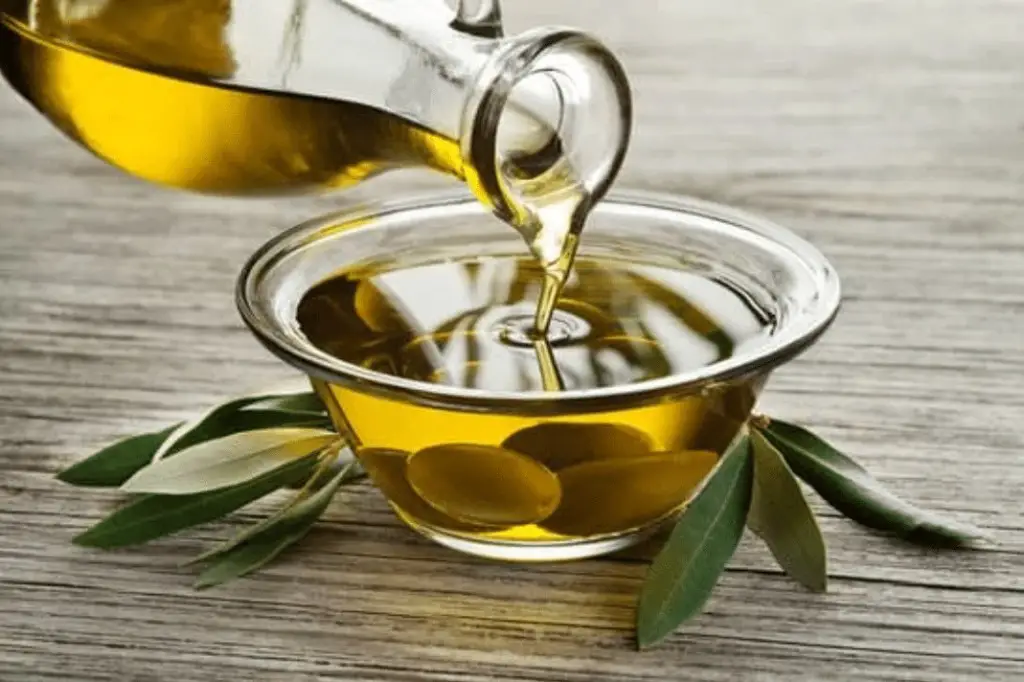
There are few oils that, used in 100% of the recipe, are able to produce good soaps: olive oil, animal fat, palm oil, coconut oil, babassu oil, rice bran oil, sweet almond oil. The purer the oil, the more natural and better the soap will be. For this reason, it is advisable to use extra virgin olive oil.
The only issue with making olive oil soap is the curing time. It takes about 6 months to have an optimal olive oil soap bar. However, I use them after 8 weeks, and… They are good. They don’t look or feel too soft. I suppose you can use them after 10 weeks of curing. Just give them a try.
Benefits of Olive Oil Soap or Castile Soap
By itself, olive oil gives good hard bars of very gentle and nourishing soap for the skin without being dry, so it is especially suitable for sensitive skin. It produces a not very abundant foam that some may find “slimy”, others will find it creamy. It doesn’t foam or lather like coconut oil, but there is nothing as moisturizing, creamy and smooth as a bar of natural olive oil soap.
The final soap is delicious, very mild and conditioning, a huge difference compared to the bath gels and soaps you buy in stores. It is probably the best handmade soap for sensitive skin. You can use it for babies older than 6 months.
My daughter started to use it with 5 years old. She had a rash in her inner tighs that disappeared with the consistent use of olive oil soap instead of the commercial bath gel for kids! It’s that good!
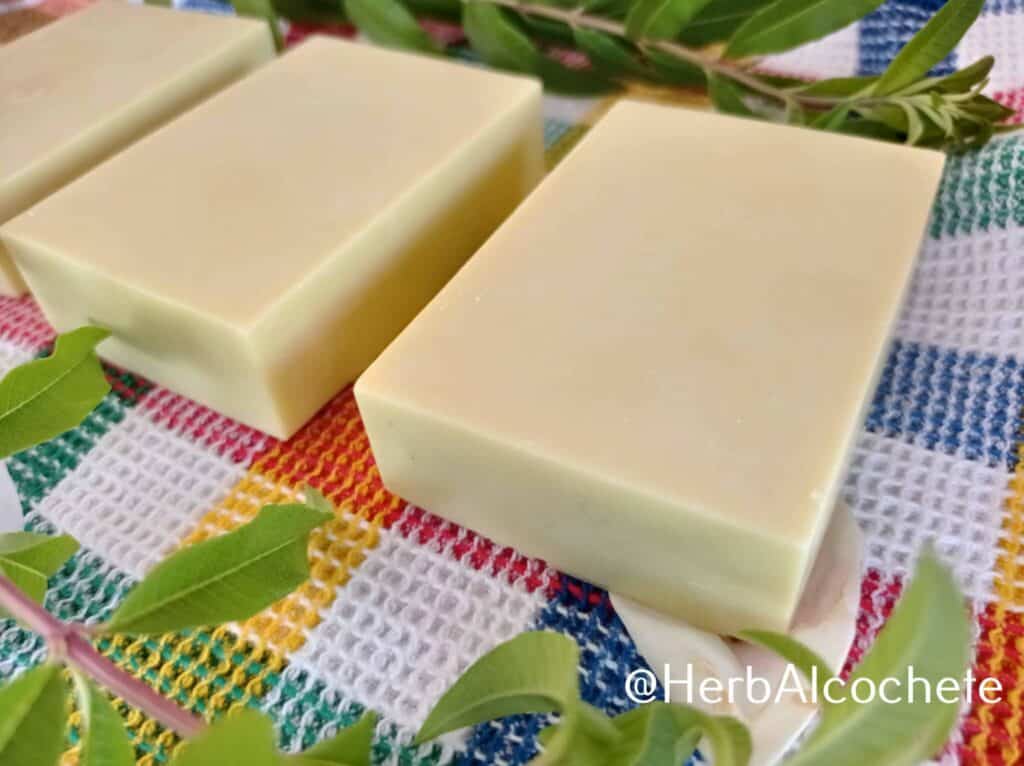
How Do You Make 3 Ingredient Olive Oil Soap?
The basic ingredients to make this soap are actually 3: olive oil, lye and water. You probably have them all at home right now! Ok, this recipe also lists some more ingredients, to enhance your soap bar. However, they are all optional, you still can make soap without them:
Sodium Lactate or Salt
This ingredient helps harden your bar. It will shorten the time of solidification from 7 days to 2-3 days, roughly. Still, I advise you to let the soap in the mold for as long as you can. In my experience, this soap has a very high chance of creating soda ash, or sodium carbonate, a white salty substance that will cover your soap with time. It’s harmless and can be removed, but if you let your soap in the mold after sprinkling it with alcohol, it has a decreased chances of creating it.
Anti-oxidant – Grapefruit Seed Extract or Other
Your soap will have a small amount of floating olive oil in it, around 5% (it’s the superfat). Anti-oxidants help preserve these floating oils, and reduce the chance of going rancid or creating DOS (dreaded orange spots). They are also good ingredients for skin or their own: they are anti-oxidants!!
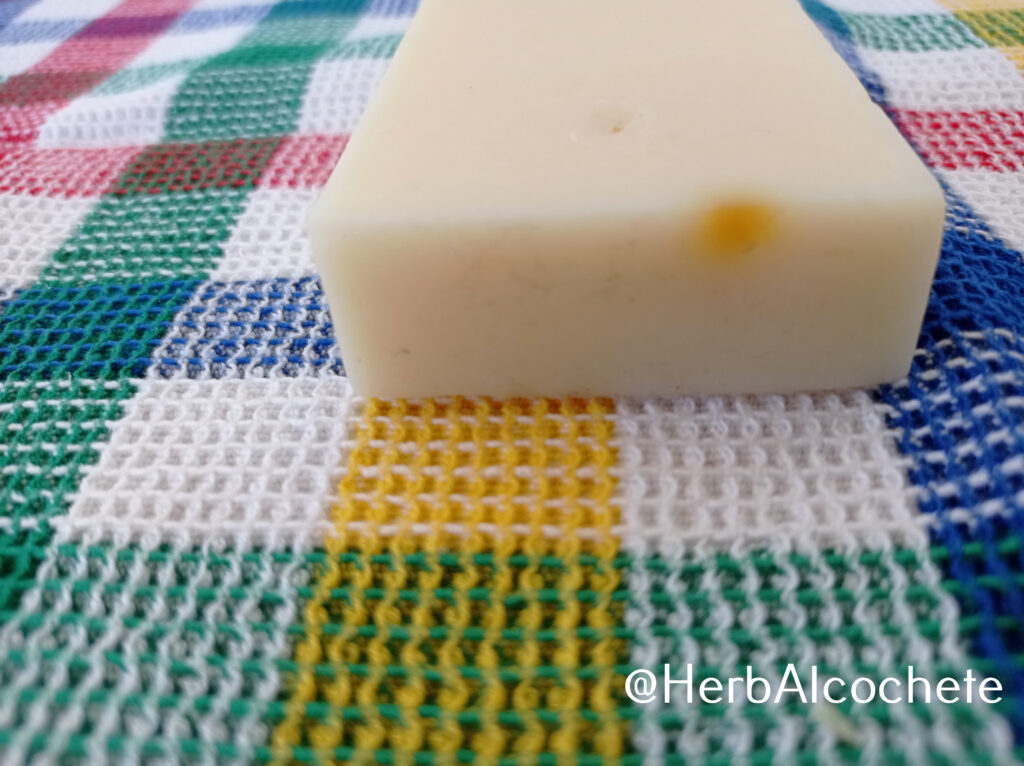
This is a must-use ingredient for me for that reason, but it’s not mandatory to make soap. On your first attempt you can skip it, provided you use fresh olive oil.
Essential Oil
I actually do like the scent of unscented olive oil soap. It’s probably unlike anything you have smelled before, but it’s good. If there’s a scent I associate with raw soap, this is it. However, we are so used to fragrant soap and hygiene products, I am sure you will be dissapointed if your first homemade soap doesn’t smell good. The lemongrass essential oil is here just for that: to give some nice lemony scent to your soap.
So, it’s your choice: make unscented olive oil soap or lemony olive oil soap, it’s totally up to you, as this ingredient is optional. Also, essential oils are expensive, and not using it will drastically reduce the cost of your homemade soap.
Have a go at this recipe and try to make castile soap at home, instead of buying it. 🙂
Find Where to Buy Handmade Olive Oil Soap (Castile Soap)
If you’re not yet ready to try to make this recipe at home, but you still wish to enjoy a natural castile soap, you can find handmade olive oil/castile soap in the following links:
- Lavender Lemongrass Castile Goat’s Milk Soap (Etsy)
- Pure Castile Soap (Etsy)
- Dr Stamlers Real Castile Soap (Etsy)
Other Soaps – Top 20 Handmade Soap and Shampoo Bars from Apple Valley Natural Soap

How To Use This Soap
In the shower or bath, wet your hands and rub your soap in them to create a lather. Wash your hands first, then repeat the process and apply soap to your whole body using the soap directly and your hands. You may also wash your face with it. Rinse hands and body abundantly. Also wash your soap from lather before placing it in your soap dish or bag saver.
Washcloths and sponges should be avoided. Avoid washing your intimate zone and your hair, soap pH in not adequate for those parts of your body. Avoid eye contact with soap to prevent stinging. Make a patch test before using your soap. Stop using your soap if you feel any immediate adverse reaction in your skin (red skin, rashes, itching).
To take best advantage of your handmade soap (made by yourself or store-bougth), read How Do You Use Handmade Soap?
Related Posts
Ingredients and Recipes
- Vegetable oils: Oil Properties For Soap Making
- Essential oils: Best Essential Oils for Soap Making
- Colorants: How To Color Your Soap With Kitchen Ingredients
- Beginner Recipes: Soap Recipes for Beginners
- Cold Process Soap Recipes: Free Cold Process Soap Recipes
Soap Making Techniques and Troubleshooting
- Cold Process Tutorial Guide: Learn To Make Cold Process Soap?
- Soap Making Methods: How To Make Soap At Home
- Soap Making Trace: Know Everything About Trace in Soap Making
- Soap Acceleration: Causes, How To Avoid It Or How To Fix It
- Soda Ash In Soap: What It Is, How to Remove It
Watch This Video About Safety
Cold Process Soap Making Tutorial Video
Cold Process Soap Making Lessons
The tutorials in this blog are a great – and free! – help to start with cold process soap making. Practice is the next step to harness the art of making soaps at home. However, I understand if you prefer to have some formal lessons, where you will feel more supported with the steps. Feel free to join these courses at Udemy.
Equipment
Ingredients
Lye Water
- 52 g distilled water
- 29 g lye (100% sodium hydroxide)
- 0,5 tsp sodium lactate or fine salt
Oils
- 225 g extra virgin olive oil
Add After Trace
- 4 drops grapefruit seed extract (GSE) (anti-oxidant)
- 6,5 ml essential oil lemongrass (optional) you can also use peppermint / litsea cubeba / lavender)
Instructions
Get Ready!
- Wear goggles and gloves! Look at “Safety Precautions” in the video above or in Soap Making Safety Precautions
- Watch the video above about "Cold Process Soap Making Tutorial" or read the post Learn To Make Cold Process Soap for instructions on cold process soap making before starting. These are generic but important steps for all recipes.
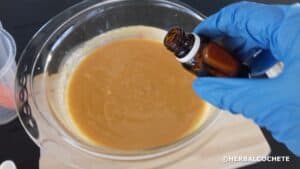
- Assemble everything: ingredients, equipment, safety equipment. Prepare your workstations. Measure all the ingredients. Don’t start the recipe without having everything ready!
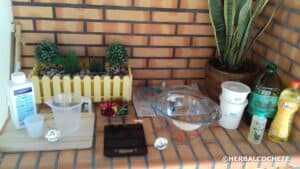
- The essential oil is optional. It adds scent to soap. I have suggested lemongrass for this soap, but you can choose your favorite between peppermint, litsea cubeba, tea tree or lavender, or a blend. Just don't exceed the quantity.
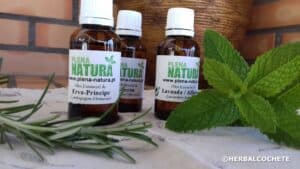
Prepare the Lye Water
- Make the lye solution according to How To Make Lye Water. If using fine salt, add it to the water and dissolve it very well before doing the mixture. Add the lye and mix it until the vapors start to dissipate and the water clears. Strain it to catch any undissolved lye crystals.
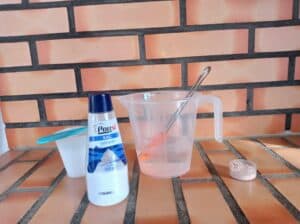
- If using sodium lactate, add it in cooled lye water (below 55ºC – 130ºF) and mix well.

Heat the Oils
- Heat the olive oil to aprox. 35ºC – 40ºC (95ºF – 104ºF). This step is only to speed up trace, you can actually use it at room temperature.
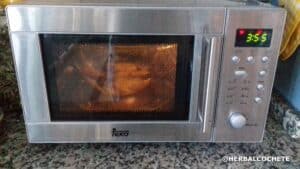
Make the Soap Batter
- Use as a target temperature 35ºC-40ºC (95ºF – 104ºF) for the oil-solution mixture. This recipe has a water discount to reduce trace time and cure time. Higher temperature also helps to reach trace. However, I've made this soap at 30ºC room temperature (it was a hot summer day) and took me 11 minute to reach trace.

- Mix the lye water with the oils. Pour carefully using a spatula.
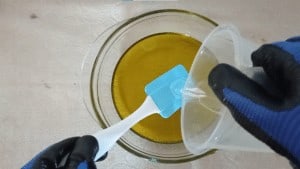
- Reach trace with the immersion blender. Recipes of 100% olive oil soap take time to reach it, you may need to use the stick blender for about 10-15 minutes. In the end, it should be a liquid opaque pale yellow batter.
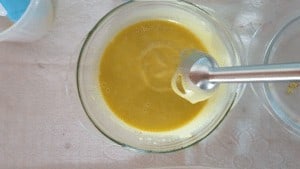
- After trace, add the extract and essential oil. Mix with a spatula.
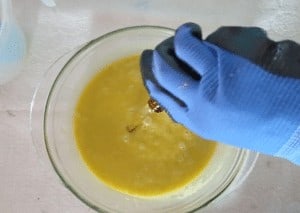
- Pour the soap batter in the molds with a pitcher. I don't recommend using box soap molds for olive oil, only silicone ones. Sprinkle with alcohol or witch hazel. You can put in pre-heated oven for gel phase.
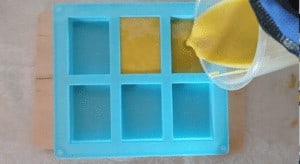
Molding and Curing
- 100% olive oil soaps take time to solidify. By using sodium lactate or fine salt, your soaps will solidify faster. However, it is advisable to leave it in molds for up to 7 days, because of soda ash. Let the soap set in molds for 2 to 7 days (depending on your patience 🙂 )
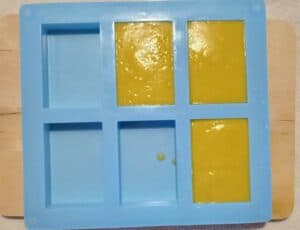
- Unmold and let the bars cure for 8 weeks minimum. Some soap makers state that Castile soap bar is optimal at 6 months. Maybe because I always use sodium lactate or salt, mine are good to go after 2 months. See How To Cure Soap.
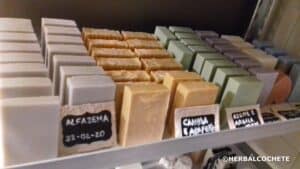
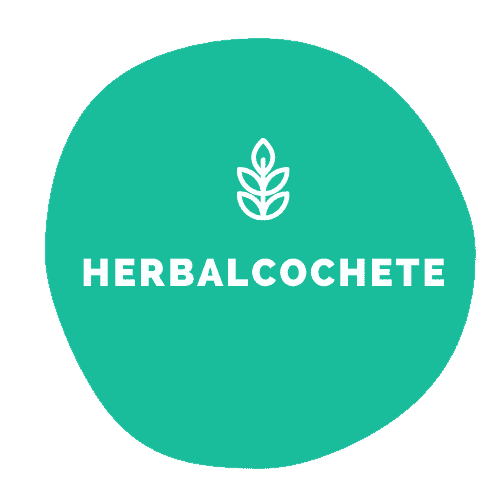


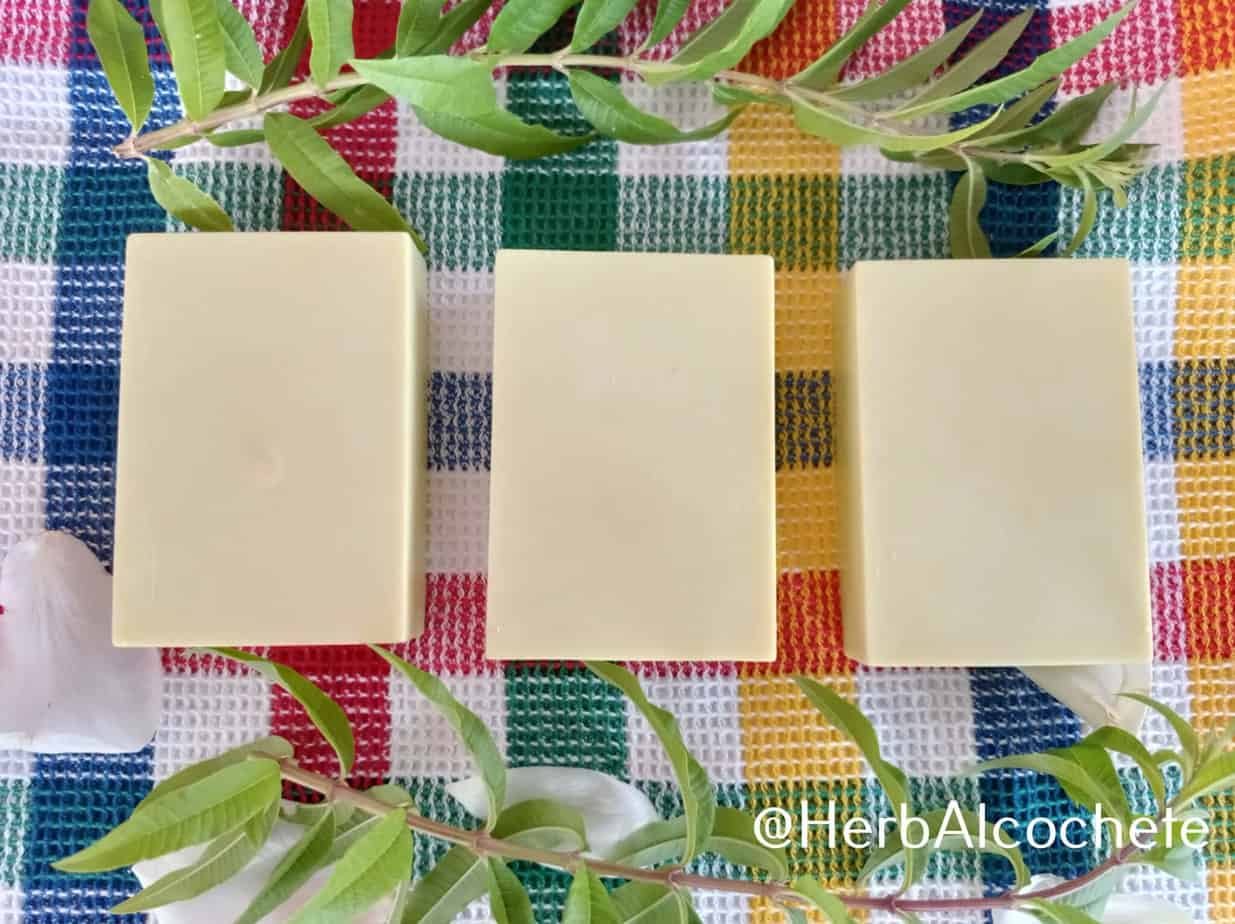
Hi Sofia, I have a sister named Sophia. Spelled with a ph though and guess what? She loves natural soaps, creams, hair products, anything natural lol.. I will share your site with her I am sure she will enjoy it. But I didn’t realize natural homemade soaps was this easy to create, seems the hardest part is the 6-8 weeks to cure. Thanks for sharing your recipes Sofia!
Hello CeCemorgan, your comment was very warming to me 😀 thanks a lot! I hope your sister checks my website and shares her experiences as well!
Soap making is really great, but I guess it’s a passion of mine so I am biased 🙂 but yes they are much more simple to make than we think, they can easily be made at home. Here in Portugal, our grandparents used to make soap at home, with animal fat. I know you can use ashes (filtered water from grey ashes) to make soap – ashes and animal fat were by-products for many households, so it was cheap and sustainable 🙂 . Maybe if you ask your elders in the family, maybe someone remembers someone making soap at home in older times 🙂
Cheers, Sofia
Hi, I heard many years ago that making soap was easy and I knew it can be made with many soaps, but then whenever I read about this there kept being a mention of this substance called “lye” that everyone else seemed to know what it was except me. Finally – sodium hydroxide! This is very tempting to have a go at making soap but looking at the price of the ingredients I can see that this is not exactly cheap. After all, I don’t live in an olive grove so would have to buy the olive oil This does look fun though. Thanks for this. I learned something. Best regards, Andy
Hello Andy and thanks for your comment.
Soap making is relatively easy and super fun, as long as one gets over the fear to use lye, or sodium hydroxide (yes, that’s what it is 🙂 ). Besides, the resulting soap is a wonderful product to wash yourself with.
Olive oil is in fact cheap in Portugal, around 3€/l, as we are a big producer of it. But why don’t you try this one: Homemade Coconut Oil Soap Recipe? Coconut oil seems to be relatively cheap everywhere. Use a conventional refined oil, skip scent – essential oils are the most expensive ingredients – and color – you will have a white soap – and your soap can actually be economic. Not cheap but not expensive either, and the quality is worth it.
Best Regards,
Sofia
Hello!
I am still surprised that olive oil is used in these bars and that this is almost to the top of the list of great ingredients to be included! The benefits it gives in how it is used to solidify the soap is super interesting! I do hate that it takes soo long to get the best form to be used!
Thank you for the information!
Keep Being AMAZING
Hello Brendaliz, olive oil is a must-have ingredient in soap making 🙂 Soap made with olive oil may look a bit “creamy”, as it doesn’t foam a lot, but I simply love it and use it everyday, as it is very soft, gentle, and conditioning.
As for time that takes to cure, it’s true that best things in life take time to get 🙂 some soaps made with salt, might take around 6 months to cure, but I was told they are simply amazing. I am yet to experiment them.
Cheers, Sofia
Hallo,
I am here to offer my comments about your site “HerbAlcochete”
The site is well designed and created, all the menus are clear plus the Title Name, But there is only one problem with the Site contents and the Menus,
This is when you click on a content or Menus, Someone or I expect it to open in a New Window but from your site the Contents and the menus all open from within the webpage which makes someone who has gone forward like five pages very difficult to press back five times.
So if you can only improve this one from your settings or designs you will be doing well in the future.
What would you call your Site, A manufacturing site or a Promoting Site?
Thanks that’s all I had for you.
Hello, and thanks for your comment, suggestions are much appreciated.
Blogs are just built like that though, they are supposed to show their posts in the same main window. If you wish to open many posts in new windows you can use the “CTRL” key while clicking on the post. Hope this helps and enjoy my website.
Cheers, Sofia
Hello!
How easy it is to make castile soap at home!
Thanks for this recipe!
Hello and thanks for your comment!
Hi Sofia,
Curious if there is anything else you can use in place of the grapefruit seed extract?
Looks like a great recipe…going to give it a try!
Thanks, Sarah
Hello Sarah, thanks for your interest in this olive oil soap recipe, definitely my favorite 🙂
Yes, you can use rosemary oleorresin extract or even vitamin E oil (I usually double the number of drops when using vitamin E oil). These are all strong natural antioxidants. One thing I’ve also learned to use to prevent rancidity, is to use citric acid as a chelator, but it’s tricky to let you know how to do it without remaking the recipe. One thing you can do to prevent rancidity as well is to use fresh extra virgin olive oil.
Hope this helps!
Cheers,
Sofia